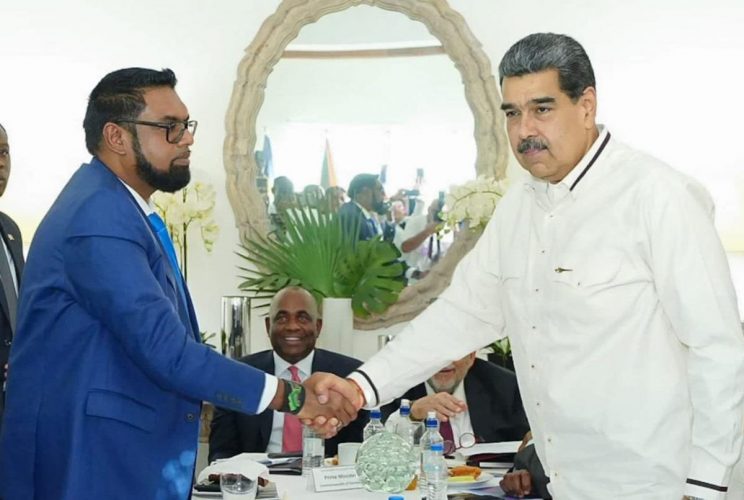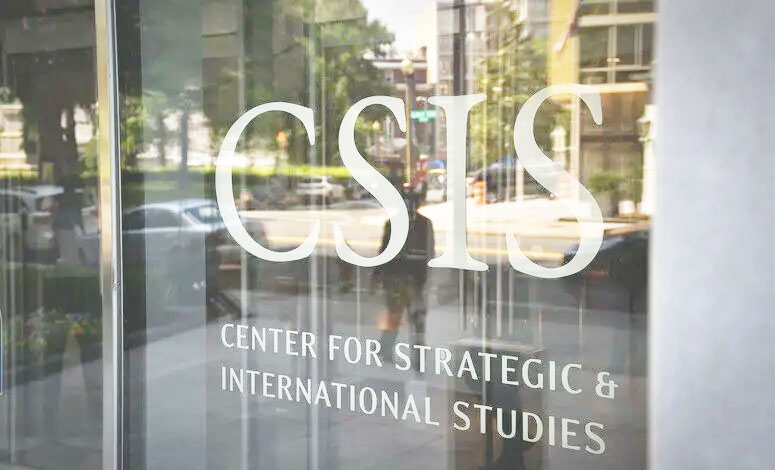Citing a Venezuelan military buildup along several parts of the frontier with this country, US think tank, CSIS, has posited that Caracas is engaged in a carrot and stick strategy to extract concessions from Guyana even though Georgetown is adamantly pursuing a resolution of the longstanding border controversy before the World Court.
In a February 9th analysis, the Center for Strategic and International Studies (CSIS) published satellite images of a military buildup on the Venezuelan side of the border which it said strongly supported its hypothesis of `compellence’ where Caracas was seeking to wrest concessions from Guyana such as possible joint exploration of natural resources.

Tensions between the two countries reached a boiling point last year after a Venezuelan referendum was held on December 3rd seeking the annexation of Guyana’s Essequibo. The ensuing friction led to the convening of the high-level Argyle meeting on December 14th in St Vincent and the Grenadines where both President Irfaan Ali and Nicolas Maduro were present and which yielded a declaration in which both countries eschewed the use of force or threat of the use of force in resolving issues between them.
Notwithstanding the Argyle Decla-ration, CSIS published satellite images generated by Maxar Technologies showing reinforcements as recent as last month on Ankoko Island in the Cuyuni River. Half of Ankoko belonged to this country but was seized by Venezuela in 1966 just after Guyana gained independence.
The analysis titled `Miscalculation and Escalation over the Essequibo: New Insights into the Risks of Venezuela’s Compellence Strategy’ said the thesis as outlined by Thomas Schelling entails combining the threat of force with diplomatic incentives.
Authors Christopher Hernandez-Roy, Rubi Bledsoe, Henry Ziemer, Joseph S. Bermudez Jr. and Jennifer Jun said Venezuela’s participation in the Argyle process represents the diplomatic carrot, while its military engagement in provocative acts serves as a stick to shift negotiations in Caracas’s favour.
“Recent activity by the Venezuelan armed forces within the Essequibo and in nearby waters observed in satellite imagery lends credence to this argument and suggests Maduro may be duplicitous in his commitment to resolve the dispute through diplomatic channels”, the analysis said.
It noted that in the weeks leading up to the January 25, 2024 Joint Commission meeting in Brasília as mandated by the joint declaration from the Argyle meeting, Venezuela had been building up a military presence on Ankoko Island.
It said that a video, linked to the Bolivarian National Guard dated January 15, 2024, shows a staging area across the Cuyuni River from Ankoko Island where construction materials are piled up. Three armoured vehicles, likely V-100/150 Commando amphibious armoured personnel carriers (APCs) are also visible in the staging area. The analysis said that Maxar satellite imagery of the area from January 13, 2024, also shows the APCs, construction materials, a heavy river ferry and the clearing of a new area to the north, likely where Venezuelan military engineers intend to build a Mabey Compact 200 bridge to the island.
More recently, the analysis said that videos shared from Venezuelan military and government social media accounts on January 24 and 25 (the day of the joint commission meeting in Brasília) show an exercise taking place on Ankoko under the supervision of General Domingo Hernández Lárez, commander of the Strategic Operational Command of the National Bolivarian Armed Forces (FANB), who reports only to President Maduro and Defense Minister Vladimir Padrino López.
Interesting facets
The commentary said that the videos also show interesting facets of the buildup, including the presence of two Arava light short takeoff and landing (STOL) transport aircraft; a Mi-17 helicopter; an assortment of armoured equipment, including two to three types of APCs and two types of tanks; and a mix of national guard, army, and marine elements. An earlier video from January 19 explains that what is being built on Ankoko Island is a jungle tank base with a 3.8-kilometer track (2.3 miles) with 14 obstacles, which will be used to train Vene-zuela’s armoured units.
The analysis said that the videos and coordinated social media campaigns suggest that the FANB is actively displaying its activities on Ankoko as part of an information operation.
“With videos boosted relentlessly by military social media networks featuring logos, music, and editorial flourishes, the Venezuelan armed forces are intentionally crafting a message for external consumption, with one key audience being the Guyanese government”, the analysis asserted.
Compared to 2021, the analysis said that a satellite image from January 13, 2024, also reveals the beginnings of the expansion project at the base with signs of road traffic, significant ground clearing suggesting planning for additional buildings or a vehicle park, and the construction of a small fueling station— a signal of future construction and military vehicle presence.
“The expansion would likely indicate an increase in stationed personnel from platoon to company or battalion size, increasing personnel from around 50 up to and possibly over 300. Notably, a mixed group of armored fighting vehicles (AFVs) can be seen consisting of six vehicles, likely Scorpion light tanks and at least one EE-11 APC. New trails or roads have also been built from the base south through the forest to the airfield, and there is evidence of recent tracked and wheeled vehicle activity. A Bell 206 helicopter can also be seen”, the analysis added.
The presence of a military barge in Tumeremo, a heavy river ferry, and light tanks on Ankoko shows the capacity to move heavy equipment across rivers, while the EE-11 and other amphibious APCs observed could indicate an effort to build up an amphibious capability on the island.
Guyanese airfield
“This equipment constitutes a threat to the small Guyanese airfield located only 140 yards across the river”, as well as the nearby border town, the authors said.
The analysis said that FANB have not limited their movements to Ankoko Island. After Britain deployed the HMS Trent on a defence diplomacy and training mission on December 29, the analysis pointed out that President Maduro announced operation Nico Domingo Antonio Sifontes 2023, an exercise along the Atlantic Coast supposedly involving the deployment of 5,682 military personnel, coastal and maritime defense ships, tank and cargo landing ships, amphibious vehicles, seven Peykaap III (Zolfaghar) fast missile boats, helicopters, 23 fighter jets of different sorts, Buk antiaircraft missile batteries, among other equipment.
“The significant Venezuelan military resources claimed to be employed in the exercise are on a different order of magnitude than the presence of the lightly armed Trent, designed for counter-piracy, fishery protection, and search and rescue, which had been stationed in Barbados as part of counter-narcotics efforts in the Caribbean”, the analysis added.
It contended that the overreaction to the Trent may have been an excuse to reposition certain assets closer to the border with the Essequibo.
“The redeployment of at least three Peykaap III (Zolfaghar)-class guided missile-armed fast patrol boats (PTGF), which are Iranian-built, fast, and very maneuverable anti-ship missile boats, is a concerning case in point. Social media shows three of the boats on trailers were loaded on December 30 onto a Los Frailes-class landing ship in Puerto Cabello for transport towards `the Atlantic coast’ of Venezuela”, according to the authors.
Recent satellite imagery shows the boats arrived sometime between January 18 and 22 at Venezuela’s main Atlantic coast guard station in Guiria, which faces Trinidad and Tobago, just days ahead of the Joint Commission meeting in Brazil. It is possible, the analysis said, the intent is to further redeploy the missile boats to the small coast guard station at Punta Barima, located only 43 miles from Essequibo.
“Overall, these deployments of the Venezuelan armed forces point to Caracas’s efforts to try to compel Guyana to sidestep the ongoing case before the International Court of Justice, and assent to Venezuela’s preferred approach of bilateral negotiations to resolve the disputed territory’s status or extract concessions. The FANB’s presence and maneuvers on (Ankoko) on the same day as the joint commission meeting in Brasília, the redeployment of missile boats closer to the Essequibo, and the upgrading of a naval base at the mouth of the Orinoco, may allow Maduro to selectively raise the temperature along the border with the Essequibo. Combined with inducements at the negotiating table, these acts may help Venezuela to secure more favorable terms”, the analysis added.
It said that to hedge against further tensions, on February 2, 2024, the Brazilian army sent two dozen armoured cars to reinforce its forces in Boa Vista where the garrison there would become a regiment with the tripling of equipment and men. Two days later, the analysis noted that U.S. deputy national security advisor Jon Finer visited Guyana and said the two countries were “deepening [their] defence cooperation” to assist Guyana in preserving its borders.
“These moves by Brazil and the United States suggest there is more going on than the diplomatic deliberations of the Argyle Agreement or the meeting of the joint commission in Brazil”, the analysis said.
It added that the escalatory behaviour on the part of Venezuela creates opportunities for miscalculation and loss of control over events on the ground.
“The Venezuelan state is not a unified actor, fragmented as it is by corruption, criminal interests, and internal jockeying for power. It may well be the case that the buildup on (Ankoko) was undertaken to placate factions within the armed forces frustrated with the change to diplomatic negotiations and desiring to flex their muscle even as the two sides sit down to negotiate. Even if this is the case, it is not without risks, as local commanders, operating far from the locus of Venezuelan state power, may be tempted to escalate the situation on their own with further provocations or even by launching operations in the Guyanese Essequibo. Accordingly, it remains uncertain whether Maduro can effectively avoid misunderstandings and manage the forces he unleashed with the December referendum”, the analysis warned.
It said that policymakers need to be attentive to both the words and actions of the Maduro regime in navigating the Essequibo dispute and that negotiations should not overlook provocations on the border. In doing so, it said that Ankoko Island, Punta Barima, and likely other locations, stand out as areas to monitor as the March meeting between Presidents Maduro and Ali approaches.
The CSIS describes itself as a bipartisan, nonprofit policy research organization dedicated to advancing practical ideas to address the world’s greatest challenges. It was founded in 1962.





